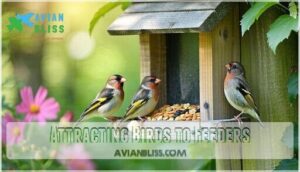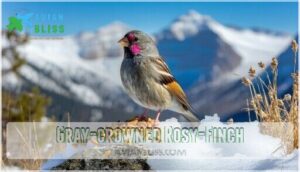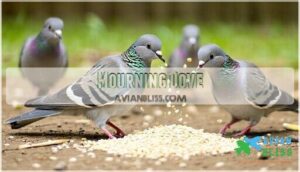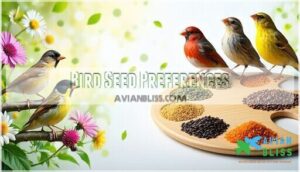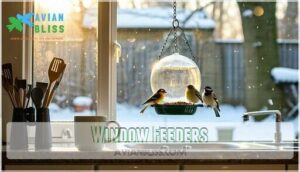This site is supported by our readers. We may earn a commission, at no cost to you, if you purchase through links.
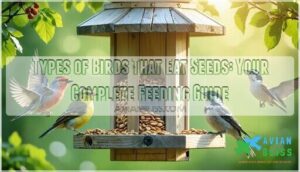 You’ll find dozens of types of birds that eat seeds, from tiny goldfinches to chunky cardinals.
You’ll find dozens of types of birds that eat seeds, from tiny goldfinches to chunky cardinals.
Finches, sparrows, chickadees, and titmice are your most common seed-eaters. Cardinals love sunflower seeds, while goldfinches go crazy for nyjer. Doves prefer millet scattered on the ground.
Nuthatches and woodpeckers also enjoy seeds alongside their usual fare. Each species has favorite seed types and feeding styles – some crack tough shells, others prefer tiny seeds.
Understanding which birds visit your area and what they crave makes all the difference in creating a bustling backyard buffet that keeps them coming back, with the right seeds and feeding styles to attract a variety of birds, including those that eat sunflower seeds and millet.
Table Of Contents
- Key Takeaways
- Birds That Eat Seeds
- Seed Types Explained
- Attracting Birds to Feeders
- Seed Eating Bird Species
- Bird Seed Preferences
- Seed Feeder Options
- Common Seed Eating Birds
- Frequently Asked Questions (FAQs)
- Which bird most likely eats seeds and nuts?
- Do grosbeaks eat nyjer seed?
- Can I just throw bird seed in the yard?
- What is the best bird feed for tube feeders?
- Do birds eat seeds?
- Which seed attracts the most birds?
- What birds eat canary seed?
- What birds eat sunflower seeds?
- Which bird eats seed?
- What type of bird seed attracts the most birds?
- Conclusion
Key Takeaways
- You’ll attract the widest variety of birds with black oil sunflower seeds – they’re easy to crack and appeal to over 40 species, including cardinals, finches, and chickadees.
- Ground-feeding birds, like doves and sparrows, prefer white proso millet scattered on the ground – while finches go crazy for tiny nyjer seeds in tube feeders.
- You can deter squirrels naturally by using safflower seeds – their bitter taste keeps pests away while still attracting cardinals and grosbeaks.
- Clean feeders regularly and use squirrel-proof designs – this prevents harmful bacteria and ensures your feathered visitors stay healthy and keep coming back.
Birds That Eat Seeds
You’ll discover dozens of bird species that rely on seeds as their primary food source, from tiny goldfinches to colorful cardinals.
These feathered visitors have evolved specialized beaks and feeding behaviors that make them perfect candidates for your backyard bird feeders.
Finches and Sparrows
Finches and sparrows represent nature’s most dedicated seed connoisseurs, each equipped with specialized finch beak adaptations for cracking tough shells.
Their sparrow social behavior and dietary adaptations vary by region, making smart seed choices essential for attracting these types of finches. Attracting sparrows is easier with millet and sunflower seeds.
- Black oil sunflower seeds – finches’ top choice
- White proso millet – sparrows’ preferred ground feed
- Nyjer seeds – perfect for small finch species
- Safflower seeds – ideal for sparrow habitats
- Mixed blends – use sparingly to prevent waste
Doves and Chickadees
While finches and sparrows prefer elevated feeders, doves and chickadees showcase completely different feeding styles that’ll transform your backyard bird watching experience.
Mourning dove ground feeding habits make them perfect candidates for scattered seed placement. These gentle birds prefer white proso millet and cracked corn spread directly on the ground or low platform feeders. Their dove bird seed preferences lean toward easily accessible options that don’t require acrobatic feeder navigation.
Black-capped chickadee adaptations tell a different story entirely. These acrobatic seed eating birds excel at tube feeders filled with black oil sunflower seeds. Their seed caching behavior means they’ll grab seeds and hide them in bark crevices for later meals.
Social behavior varies dramatically between species. Chickadees travel in mixed flocks during winter, while mourning doves often feed in pairs or small groups.
Regional diets influence preferences, so observe which seeds attract your local populations most effectively.
Titmouses and Juncos
Beyond doves and chickadees, you’ll find titmouse varieties and juncos bringing charm to your backyard.
These seed eating birds have distinct feeding habits that make them easy to attract.
Titmice prefer sunflower and safflower seeds in shaded feeders, matching their habitat preferences.
Juncos display fascinating junco behavior, foraging for white proso millet on the ground in flocks.
Their conservation status remains stable, making them reliable winter visitors.
- Place feeders in shaded areas for titmice comfort
- Scatter white proso millet on ground for juncos
- Use tray feeders to accommodate ground-foraging behavior
- Keep feeders stocked during winter months for best results
- Clean feeding areas regularly to support healthy bird species
Siskins and Redpolls
These acrobatic finches frequently visit feeders during harsh winter months.
Winter’s harshest months bring these agile seed-lovers straight to your feeders for survival.
Siskins and redpolls show remarkable thistle dependence, using specialized beaks to extract oil-rich thistle seeds.
Their social behavior includes flocking together for warmth and protection.
- Watch for their erratic, bouncing flight patterns
- Notice their tiny yellow-green bodies with dark wing bars
- Listen for their distinctive twittering calls echoing through trees
- Observe their upside-down feeding acrobatics on branches
Other Seed-Eating Birds
Many types of birds that eat seeds beyond common finches and sparrows visit feeders.
Rare seed-eaters like Clark’s Nutcracker cache seeds, helping with seed dispersal. Introduced species such as Black-faced Waxbills adapt well to backyard feeders.
Mourning dove and cardinals show unique dietary adaptations based on regional variations.
Conservation efforts support these diverse seed-eating species, making your feeder a wildlife haven. Many birds enjoy black oil sunflower seeds, which are highly nutritious.
Seed Types Explained
You’ll find five main seed types that attract different birds to your backyard feeders.
Each seed offers unique benefits and appeals to specific species based on their beak size and feeding preferences, which can be considered a complete concept in understanding bird attraction to backyard feeders.
Sunflower Seeds
Black oil sunflower seeds attract over 40 bird species with their thin shells and high fat content.
These sunflower varieties provide excellent nutritional benefits for finches, chickadees, and cardinals.
The manageable seed size and minimal shell thickness make them easy to crack.
Choose quality seeds to prevent sprouting concerns in feeders.
Consider safflower seeds, which can deter squirrels effectively, as another option.
Safflower Seeds
Why choose safflower seeds over sunflower? These thick-shelled seeds offer natural squirrel deterrent properties while attracting cardinals and grosbeaks with their unique seed composition.
- Cardinal Attraction: Cardinals love cracking safflower’s tough shells with their powerful beaks
- Squirrel Deterrent: Bitter taste keeps squirrels away from your feeders naturally
- Regional Preferences: Many areas report safflower preference among native sparrows and finches
Proper feeder placement guarantees safflower seeds birds can access easily while maintaining their pest-deterrent benefits.
Nyjer or Thistle Seeds
Feeding tiny thistle seeds brings bright goldfinches straight to your yard. These oil-rich nyjer seeds pack serious nutrition for small finches who love their needle-like shape and high energy content.
Nyjer seeds are tiny treasures, perfect for attracting vibrant goldfinches and finches to your feeders with their high-energy nutrition.
Choose specialized tube feeders with small ports to prevent waste and spoilage.
Essential nyjer feeding tips:
- Buy fresh seeds from reputable suppliers for maximum finch attraction
- Store in airtight containers to prevent rancidity and maintain seed quality
- Clean feeders weekly to stop mold growth and guarantee spoilage prevention
- Use mesh or sock feeders designed specifically for these feeder types
- Replace old seeds every few months since thistle seed birds prefer fresh food
White Proso Millet
White proso millet is perfect for attracting ground feeding birds like sparrows and doves. These small, round seeds offer excellent millet nutrition and resist spoilage better than other options.
| Bird Species | Feeding Method | Benefits |
|---|---|---|
| Sparrows | Ground scatter | Natural foraging behavior |
| Doves | Tray feeders | Easy access, less waste |
| Juncos | Low platforms | Comfortable feeding height |
Scatter white millet seeds directly on clean ground or use low tray feeders for best results.
Shelled and Cracked Corn
Cracked corn attracts ground feeding birds like doves, quails, and cardinals but also draws unwanted starlings.
Shelled corn offers easier eating for smaller beaks.
Use ground feeders or scatter directly on soil.
Corn nutrition is lower than sunflower seeds, so mix sparingly.
Store properly to prevent corn spoilage and mold formation.
Attracting Birds to Feeders
You’ll attract more birds to your feeders by choosing the right seeds and maintaining clean feeding stations.
Quality seeds in squirrel-proof feeders create a reliable food source that keeps your feathered visitors coming back year after year, making your feeders a consistent and reliable destination.
Choosing The Right Seed
Black oil sunflower seeds attract over 40 bird species with their high fat content and thin shells.
Seed nutrition matters most – fresh seeds with proper oil levels meet birds’ energy needs.
Match seed types to your target birds: safflower for cardinals, nyjer for finches, millet for ground-feeders.
Quality seed mixes with minimal filler ingredients reduce waste.
Consider seasonal seeds – birds need extra calories during migration and winter months.
Using Squirrel-Proof Feeders and Baffles
Once you’ve chosen quality seeds, protecting them from clever squirrels becomes your next challenge.
These acrobatic thieves can quickly empty feeders meant for your feathered friends.
Squirrel-proof feeders with weight-activated mechanisms show impressive baffle effectiveness, deterring 95% of attempts when installed correctly. Smart feeder placement at least 18 inches from jumping points maximizes squirrel deterrence.
Here’s your squirrel access prevention strategy:
- Install dome baffles 18+ inches diameter on poles 5 feet high
- Choose weight-sensitive feeders that close ports under squirrel weight
- Maintain 10-foot clearance from trees, decks, and fences
- Consider cage-style designs that allow small birds through mesh
- Invest in metal construction for long-term durability and cost analysis benefits
Understanding squirrel behavior helps you stay one step ahead. These persistent creatures will test every angle, but proper baffle compatibility with your setup creates an effective barrier.
Many options exist for durable feeder solutions to keep squirrels away.
Offering High-Quality Seeds
Fresh seeds make the difference in your backyard bird watching success.
Store black oil sunflower seeds in cool, dry places to maintain nutritional content. Choose organic options when possible for healthier birds.
Quality storage solutions prevent spoilage and mold growth. Skip cheap seed blends that contain filler ingredients.
The best seeds birds prefer include nyjer, safflower, and millet. Focus on proven seed varieties rather than mixed products.
Consider using black oil sunflower for ideal bird feeding.
Cleaning Feeders Regularly
Quality seeds mean nothing if your feeders become breeding grounds for harmful bacteria. Clean feeders protect bird health and prevent disease spread in your backyard flock.
Regular cleaning stops mold prevention issues and bacterial growth before they start. Your feathered visitors depend on proper sanitation practices to stay healthy. To further prevent issues, clean feeders bi-weekly with a diluted bleach solution.
Follow these hygiene practices for ideal bird health:
- Weekly washing: Use warm soapy water on all tray feeder hygiene surfaces, scrubbing away seed hulls and droppings that harbor germs.
- Monthly deep clean: Apply a specialized cleaning product (10% bleach solution) for tube feeder cleaning, targeting hard-to-reach areas where moisture collects.
- Complete drying: Air-dry all components thoroughly since dampness accelerates bacterial growth and creates perfect conditions for preventing disease problems.
Seed Eating Bird Species
You’ll find incredible diversity among seed-eating birds, from tiny finches with specialized beaks to ground-feeding doves that prefer scattered seeds.
Understanding which species visit your feeders helps you choose the right seeds and create an effective feeding station that attracts your target birds, which is crucial for making the most of your feeding station.
Gray-crowned Rosy-Finch
Alpine specialists, graycrowned rosyfinch thrive in high-altitude habitats above treeline.
These hardy finches showcase remarkable high-altitude adaptations, surviving harsh mountain conditions through specialized breeding habits and diet variation.
Their plumage characteristics include distinctive gray crowns with rosy wing patches.
| Characteristic | Details |
|---|---|
| Habitat | Alpine ecosystems, rocky slopes |
| Seed Preferences | Sunflower, wild grass, mustard seeds |
| Elevation Range | 6,000-14,000 feet |
| Conservation Status | Stable populations |
You’ll find these finches visiting feeders during winter months when they descend from alpine ecosystems seeking reliable food sources.
Black Rosy-Finch
You’ll spot the black rosy-finch in harsh high-altitude habitats above 10,000 feet.
This tough finch thrives where snow lingers year-round.
Diet includes sunflower seeds, thistle, and wild grass seeds from alpine ecosystems.
Identification features dark charcoal plumage with rosy wing patches.
Behavior shows ground-foraging in small flocks.
Conservation efforts protect fragile mountain environments these finches need to survive.
Brown-capped Rosy-Finch
High-altitude habitats challenge most finches, but Brown-capped Rosy-Finches thrive in Colorado’s mountain peaks.
These specialized types of birds that eat seeds prefer thistle and small sunflower varieties at feeders.
Conservation efforts protect their shrinking alpine territories.
Their behavior includes ground-foraging and rock-crevice nesting.
Identification requires careful observation since browncapped rosyfinch features closely resemble other rosy-finch species.
- Habitat loss threatens their mountain homes – climate change pushes them higher up slopes
- Winter survival depends entirely on finch bird seed sources – harsh conditions demand constant feeding
- Their rarity makes each sighting precious – spotting one feels like discovering hidden treasure
- Specialized diet limits their flexibility – they can’t adapt easily to changing food sources
- Conservation status reminds us time is running out – protecting highaltitude habitats becomes urgent
Asian Rosy-Finch
Found in remote Asian mountains, the Asian Rosy-Finch thrives in high-altitude habitats where few types of birds that eat seeds can survive.
These finches prefer various seed types throughout seasons – nyjer in spring, sunflower seeds during harsh winters. Their diet adapts to available resources in alpine environments.
Despite challenging breeding conditions in isolated terrain, their conservation status remains stable. Identification features include distinctive rosy plumage patterns.
Mourning Dove
Unlike their mountain-dwelling cousins, mourning doves are common backyard visitors you’ll recognize by their distinctive cooing calls.
These ground-feeding specialists consume enormous quantities of whole seeds daily, favoring white millet and cracked corn scattered on platform feeders or bare ground.
Here’s what makes doves unique seed-eaters:
- Their muscular gizzards grind tough seed shells with ingested grit and small stones
- They can store up to 17,000 seeds in their expandable crop for later digestion
- Ground feeding behavior makes them excellent cleaners beneath your other bird feeders, utilizing their ground feeding behavior to aid in cleaning, and their ability to eat large quantities of seeds, including cracked corn.
Bird Seed Preferences
Understanding which birds prefer specific seeds helps you attract your target species and reduce feeder waste.
Different birds have evolved specialized beaks and feeding behaviors that make them naturally drawn to certain seed types over others, which is a key factor in determining the types of seeds to offer.
Birds That Eat Sunflower Seeds
Sunflower seeds attract over 40 bird species to your backyard feeders.
Cardinals, chickadees, finches, nuthatches, and woodpeckers all love these nutritious treats. Black oil sunflower seeds work best since their thin shells make cracking easier for smaller birds.
The high fat content provides essential energy, especially during cold months. Many birds practice seed caching behavior, storing extras for later.
Their specialized beak adaptations help different species crack shells efficiently, making sunflower nutrition accessible year-round. House sparrows also enjoy this treat, and consider sunflower seeds like candy.
Birds That Eat Safflower Seeds
Safflower seeds create a Cardinal Preference that backyard birders love. These bitter-tasting seeds act as a natural Squirrel Deterrent while attracting cardinals, tufted titmice, and chickadees.
Mourning doves also visit safflower feeders regularly.
- Grosbeak Attraction: Evening and rose-breasted grosbeaks seek safflower during migration seasons
- Feeder Placement: Position safflower feeders in Shaded Feeders locations near shrubs for cardinal comfort
- Seed Preferences: Cardinals choose safflower over sunflower when both options are available nearby
Birds That Eat Nyjer Seeds
American Goldfinches top the list of nyjer seed enthusiasts, along with pine siskins, house finches, purple finches, and redpolls.
These tiny black seeds match perfectly with finch beak adaptations for cracking small, oil-rich food sources.
Siskins and thistle seeds create an irresistible combination during winter months.
Redpoll feeding habits include hanging upside-down on specialized feeders.
Nyjer seed quality directly affects bird visits – fresh seeds attract more american goldfinch activity than stale ones.
Birds That Eat Millet
While nyjer seeds work well for finches, millet attracts ground-feeding birds that prefer different feeding habits.
White proso millet ranks as the top choice for birds that forage on the ground. These small bird seeds provide excellent millet nutrition through high carbohydrate content. Ground foragers like native sparrows, juncos, and cardinals actively seek millet seeds scattered below feeders.
Different millet varieties show regional preferences across North America:
- Song sparrows and white-throated sparrows consider millet their preferred seed choice
- Dark-eyed juncos gather in flocks to eat millet during winter months
- Mourning doves swallow whole millet seeds and digest them in their gizzards
- Northern cardinals crack open larger millet seeds with their powerful beaks
- Brown-headed cowbirds visit feeders regularly when millet is available
Seasonal consumption peaks during fall and winter when insects become scarce. Offer millet in tray feeders or scatter it directly on clean ground near protective shrubs for best results.
Seed Feeder Options
You’ll find three main feeder types that work best for seed-eating birds: tray feeders for ground-foraging species like doves and sparrows, tube feeders for finches and chickadees, and window feeders for close-up viewing.
Each feeder type attracts different bird species based on their natural feeding behaviors and preferences, which is a key factor in choosing the right feeder for your backyard.
Tray Feeders
Tray feeders offer the most welcoming platform for attracting diverse seed-eating species. Their flat surface accommodates ground feeding birds like juncos and sparrows alongside perching birds.
However, tray feeder design requires careful consideration of seed spillage issues and weather protection. You can find a variety of different tray models online.
| Feature | Benefit | Challenge |
|---|---|---|
| Large surface area | Multiple bird species can feed simultaneously | Higher seed spillage issues |
| Mesh bottom design | Excellent drainage prevents mold growth | Requires frequent cleaning |
| Platform accessibility | Attracts ground feeding birds easily | Increased predator vulnerability |
| Versatile seed types | Accommodates various seed preferences | Weather protection needed |
| Easy refilling | Simple maintenance routine | Regular monitoring required |
Choose tray feeders with drainage holes and consider adding covers for weather protection while maintaining easy access for your feathered visitors. This will help ensure a simple maintenance routine and provide excellent drainage to prevent mold growth.
Tube Feeders
While tray feeders spread the welcome mat wide, tube feeders offer precise seed flow control that keeps your backyard visitors coming back.
These vertical cylinders feature multiple feeding ports that let several birds dine together without the chaos.
Tube feeder design protects seeds from rain and snow, maintaining freshness longer than open platforms. The narrow ports work perfectly for finches enjoying nyjer seed birds love, while larger openings accommodate sunflower seeds for chickadees and nuthatches. Recycled plastic feeders offer lifetime durability.
- Weather protection keeps bird seed blends dry during storms
- Squirrel deterrence becomes easier with weight-activated perches
- Seed capacity holds more food than most other feeder types
- Cleaning challenges stay minimal with removable bottom trays
You’ll find tube feeders attract smaller songbirds while naturally discouraging larger, aggressive species. Their compact design fits perfectly in tight spaces, and refilling stays simple through removable tops.
Window Feeders
Window feeders transform your glass panes into front-row seats for backyard entertainment. These compact feeders use suction cups for feeder placement directly on windows, bringing finches and chickadees within arm’s reach for incredible bird visibility.
You’ll enjoy indoor viewing while sipping coffee as sparrows munch sunflower seeds just inches away. The height provides natural squirrel deterrents, though consider glass safety with decals to prevent collisions.
suction cup installation
Common Seed Eating Birds
You’ll recognize these four birds as the most common visitors to backyard seed feeders across North America.
Each species has unique feeding habits and seed preferences that make them easy to attract and identify.
American Goldfinch
When you spot an American Goldfinch, it’s like a drop of sunlight landed in your yard.
These small finches are picky eaters, showing off some fascinating Dietary Adaptations.
If you want to attract them, use this checklist:
- Fill feeders with nyjer (thistle) seeds, their absolute favorite.
- Offer black oil sunflower seeds as a backup, especially during Seasonal Molting.
- Keep feeders clean and place them in safe, open spaces—goldfinches are social and often feed in flocks.
- Stock up in winter; natural food is scarce, so your feeder becomes a lifeline.
Their finch diet supports their bright plumage and energetic Social Behavior.
Watch for changes during Breeding Habits.
The Conservation Status of the American Goldfinch is stable, making them a welcome guest.
House Finch
Curiosity and color make the House Finch a favorite at backyard feeders.
With a strong beak adaptation, these finches crack open black oil sunflower seeds, millet, and safflower with ease.
Their seed preferences shift with habitat influence and social behavior, often gathering in small flocks.
You’ll attract them best using tube feeders.
Choosing organic birdseed supports conservation status and health.
Keep feeders stocked year-round for regular visits, and watch their finch diet change with the seasons.
Black-capped Chickadee
Black-capped chickadees thrive on blackcapped chickadee favorites like sunflower seeds at your bird feeders.
These acrobatic birds showcase unique Caching Behavior, storing thousands of seeds in bark crevices for Winter Survival.
Their complex Social Hierarchy and distinctive Vocalizations make them backyard stars.
Seed preferences include black oil sunflower and birdseed mixes.
Their Habitat Preferences favor wooded areas near feeders, where they grab-and-go with seeds.
Tufted Titmouse
Tufted Titmouse birds enthusiastically visit feeders offering black oil sunflower seeds and safflower seeds.
These social birds display unique foraging habits and specific habitat needs that make backyard feeding successful.
Here’s what attracts Tufted Titmouse to your yard:
- Seed Preferences: Black oil sunflower seeds remain their top choice, though they’ll accept safflower seeds readily.
- Social Behavior: Unlike chickadees, they store seeds individually rather than grabbing multiple at once.
- Vocalizations: Their distinctive "peter-peter-peter" calls announce their presence at feeding stations.
- Nesting Preferences: They prefer tube and platform feeders positioned near tree cavities where they nest.
Frequently Asked Questions (FAQs)
Which bird most likely eats seeds and nuts?
You’ll find cardinals are your best bet for seed and nut eaters. Their thick, powerful beaks crack tough shells with ease, making sunflower seeds and nuts their favorites.
Do grosbeaks eat nyjer seed?
While grosbeaks can technically handle nyjer seed with their powerful beaks, they don’t typically prefer it. You’ll have better luck attracting them with safflower or sunflower seeds instead.
Can I just throw bird seed in the yard?
Yes, you can scatter bird seed on the ground, but it’s not ideal.
Ground feeding attracts doves, sparrows, and juncos who naturally forage there, but seed gets wet, moldy, and attracts pests.
You’ll waste money and potentially harm birds with spoiled food.
What is the best bird feed for tube feeders?
Like a VIP dining room for feathered guests, tube feeders work best with black oil sunflower seeds.
Their thin shells and high fat content attract over 40 species, especially finches, chickadees, and cardinals who easily crack them.
Do birds eat seeds?
Birds absolutely eat seeds – they’re nature’s feathered gardeners!
Over 40 species love black oil sunflower seeds, while finches adore tiny nyjer seeds.
You’ll spot cardinals cracking safflower seeds and sparrows enjoying millet on the ground.
Which seed attracts the most birds?
Over 40 seed-eating bird species prefer black oil sunflower seeds! You’ll attract the most birds with these high-fat, thin-shelled seeds that finches, cardinals, chickadees, and nuthatches can easily crack.
What birds eat canary seed?
Canary seed attracts small songbirds like finches, canaries, siskins, and goldfinches.
You’ll also see sparrows, buntings, and redpolls visit feeders.
These tiny, glossy seeds provide excellent nutrition for birds with delicate, pointed beaks designed for handling small seeds effectively, which is crucial for birds like goldfinches.
What birds eat sunflower seeds?
You’ll attract over 40 bird species with sunflower seeds.
Cardinals, chickadees, finches, nuthatches, and woodpeckers can’t resist them.
Black oil sunflower seeds work best – they’re easy to crack and packed with fat.
Which bird eats seed?
Birds of a feather flock together," but many species share similar seed-eating habits.
You’ll find finches, sparrows, cardinals, chickadees, doves, and juncos all enjoy various seeds like sunflower, millet, and nyjer based on their beak adaptations, which determine the types of seeds they can eat, such as sunflower.
What type of bird seed attracts the most birds?
Black oil sunflower seeds attract the most birds because they’re easy to crack and packed with fat.
You’ll draw over 40 species including finches, chickadees, cardinals, and sparrows to your feeder with this versatile seed choice, which is likely due to the fact that they’re easy to crack and packed with fat.
Conclusion
Discovering the many types of birds that eat seeds opens up exciting possibilities for your backyard.
You’ll attract finches with nyjer, cardinals with sunflower seeds, and doves with scattered millet.
Each species brings unique feeding behaviors and preferences to your yard.
By matching the right seeds to the right feeders, you create a thriving habitat that supports diverse bird populations year-round while providing endless entertainment, with unique feeding behaviors and diverse bird populations.
- https://valleyfarms.shop/blogs/news/vermivores-vs-seedeaters-who-s-who-in-the-world-of-wild-birds
- https://birdreel.com/blogs/news/diet-and-nutrition-in-wild-birds-a-scientific-perspective
- https://southernstates.com/blogs/how-to-library/types-of-bird-seeds-attracting-wild-birds
- https://www.birdforum.net/threads/finches-eating-me-out-of-house-home.148987/
- https://birdseedandbinoculars.com/wordpress/which-feeders-attract-which-birds/


